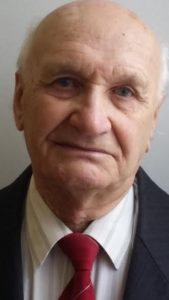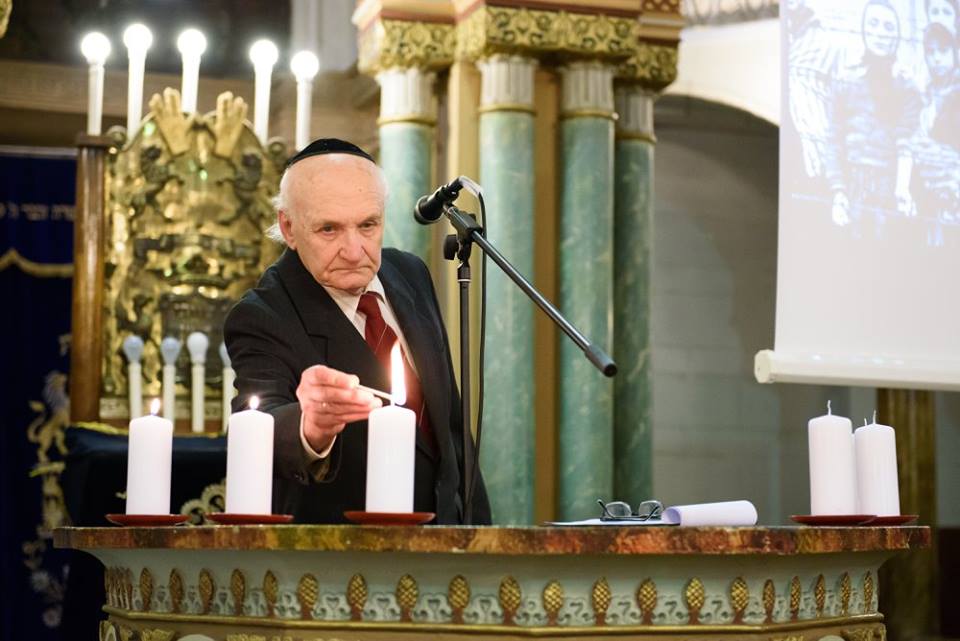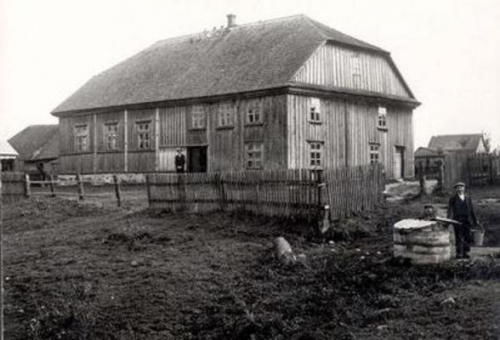Until World War II, the majority of the residents of the western Lithuanian town of Šilalė were Jews. The brick synagogue was built sometime around 1910 to 1914 at what is now the corner of V. Kudirkos street and Maironio street. There is a hardware store there now. The old Jewish cemetery is now pasture for livestock, with just the Holocaust mass murder site next to it fenced off.

Lithuanian Jewish Community member Ruvin Zeligman is the sole survivor of approximately 1,500 Šilalė Jews murdered in the Holocaust. He was 10 when World War II began in Lithuania in 1941.
Although he hasn’t lived in Šilalė for many years now, when he speaks he still falls into the western Lithuanian dialect. His wife also comes from the region and they speak in dialect at home.
Zeligman remembers the great fire which ravaged the town in 1939, burning down his family home and the entire street, taking a terrible toll on the town’s mainly wooden buildings.
How do you remember Šilalė when you lived there with your parents and family?
At that time about 60% of Šilalė’s population was Jewish. My father was a religious figure: the cantor, mohel [performer of circumcision], a religious teacher and a reznik [a man educated in the rules of kosher slaughter]. My father graduated from the famous Telz yeshiva. He was a respected man and he helped the local residents of Šilalė with his knowledge of medicine, healing the sick. There were four of us children in the family. Mother took care of the home and the children. We lived well, back then each of us, the four children, had a golden goblet at home and mother used to bring out a silver candleholder for holidays.

Zeligman lights candles for the murdered Jews of Šilalė at the Choral Synagogue in Vilnius
How did you get along with neighbors? What were their views on Jews?
We got along very well with neighbors. When our house burnt down–it was insured–Lithuanians rented us one half of a house, a three-room apartment.
The Šilalė Jewish community was very affluent. Even thought it is a small town, there were more than 10 Jewish shops there, including a shoe store, a shop selling material, two butcher shops and a number of food stores which sold on credit. I remember during the Sabbath on Saturdays Jewish shopkeepers were not allowed to accept money, so they used to say: “Put your money down here and take what you need.” All Jews spoke Yiddish, and there were some who didn’t know Lithuanian, but we played and had Lithuanian friends, so we learned Lithuanian. I remember after I finished fourth grade a took a test with Lithuanians and we had to take dictation. I did well at school. I went to a Jewish religious school next to the synagogue where there were four grades taught in the same classroom. That fateful summer I wanted to take a vacation, I thought I would continue school in fifth grade at the Lithuanian school. My sister attended the gymnasium.

The Šilalė synagogue
Tell me more about your school. How did you study, and who were your teachers?
There was a Jewish woman who taught at the religious school, she taught in Jewish, and there were four lines of benches in the classroom. One teacher taught everyone at the same time, she was very strict, and sometimes we were swatted on our fingertips or derrière. It was hard for her to control four grades at once. She used to give assignments and we would be talking, so she walked around the room with the stick. I got swatted with the switch as well: once I accidentally broke the window throwing a ball.
How did your parents raise you at home? What were the mandatory rules of behavior?
We were raised religiously at home. I remember Sabbath. We picked up, cleaned up the house as the sun was setting Friday evening, no work allowed, it was holy. Mother set the table, stretched out a white tablecloth, always lit the candles, baked challa, prepared fish and the special Sabbath dish cholent. We used to take it to the baker. They baked bread in the oven there and we used to put the pot in so it would stay hot, and Saturday morning, on the way back from synagogue, we would take it, go home and eat. I can taste even now how delicious it was. Nowadays sometimes we get cholent at the Vilnius synagogue, but it’s completely different, because in my childhood it was made with delicious lamb and carrots. We’ve tried to make it at home, my wife and I, but we don’t end up with cholent, we get Georgian [sic, Armenian] chanakh instead! (laughs).
When did the Nazis enter Šilalė in 1941? What happened in town?
Because Šilalė is not far from the German border [before World War II], the Germans invaded on the very first day of the war, on June 22. People tried to flee, but not all were able. There were Germans who lived in Šilalė before the war with whom we got along well, so no one expected it to be so horrible. On the eve of war we children went to the Russian military garrison in Šilalė to watch cinema films, and in the morning we woke up to a state of war. We tried to run, but didn’t get far. The Germans caught up with us. We went back.
Did the behavior of your Lithuanian neighbors change when the Germans entered Šilalė?
The behavior of Lithuanians did change. It was bad. We lived with our landlords who had rented us half of their home. They wanted to hide us, but didn’t have any place to put us. The Germans immediately began to mock Jews, attacking men with beards, cutting them with blades, and cutting faces, too. White armbanders from surrounding villages suddenly appeared, and there were a great many of them. They were young men and set up in the large hall of the fire station. I know their names, which are listed in the Jewish encyclopedia published in Israel. I am mentioned in it as a survivor and those who did the shooting are also mentioned. Many of them fled to Germany after the war, and after that to America.
My sister attended the gymnasium. During summer vacation she wanted to earn some money and got a job at the post office as a telegrapher. A boy from her class went there and killed her.
On July 6 they herded Jews into the synagogue. The white armbanders threw grenades in through the windows at night. My father was wounded, my brother died, I hid in a closet and I was fortunate, I survived. The next day they took us to the Jewish cemetery. There were large pits already dug there awaiting us. They began to shoot everyone and I saw my father fall into a pit… Then the synagogue caretaker Sames asked one of the guards to give him a cigarette before death. The guard was about to get him one out, and Sames attacked, bit him in the throat. Chaos ensued and that’s when I hid behind some large trees which grew in the cemetery, then ran, waded through the river and hid. That’s how I was the only one to survive. I hid across the creek, I lay there all day not knowing what to do. I went home. At that time a German came to take our things. There was only one German who participated everywhere, all the rest were white armbanders, both in the shooting and seizing property. The white armbanders stole everything, they took beds away for themselves since they were beautiful beds, golden goblets, they took everything. I began to scream, they grabbed my father’s large butcher knife and wanted to cut me, so I jumped out the window, which was open, and ran. I didn’t know where to run.
What happened to your mother? How was she then?
At that time the women and children hadn’t been murdered yet. I went to them and lived there for more than a month. In August they took the women and children away, telling them to take as much property as possible, and marched them to the Tubyniai forest were two large pits had been dug. They marched them in groups, not all at once. They shot them. Not wanting to run out of ammunition, they grabbed the small children by the legs and smashed their heads into trees, then threw them in the pit. There was a creek nearby, and it ran red with blood, all the water was red. They murdered a great number of people there.
You were left on your own as all this happened. Did your young mind comprehend what you had experienced?
I saw all of it. I managed to escape. Perhaps God wanted me to survive. I was small, thin. I knew my mother’s relatives lived in the town of Varniai, I fled through the forest to them and slept in the forest at night. I lived with my relatives for some time, but soon they marched all the Jews into the Telšiai ghetto, and I ended up there, too. Before New Year’s I found out they would liquidate the ghetto and the women told me to run, some of them ran away with me. I often used to crawl through the fence and go begging for food for me and the others, and used to bring it back. The ghetto was in the center of Telšiai. I fled again. I returned to Šilalė through the forest, to the home of the Lašaitis family where we rented before the war. People trying to save me sent me into the countryside, first to the village of Jokūbaičiai, but there, close to Šilalė, was dangerous, so I moved to the Žvingiai settlement where I hid during the whole war. In a hideout set up in the rye in summer, and in a barn during winter. No one saw me. My rescuers, Povilas and Marijona Stonkus, they were given awards for rescuing me, given the title of Righteous Gentiles. I hid until October, 1944, until liberation.
What happened after the war? You were an orphan, who helped you?
I returned to Šilalė. The Lašaitis family again helped me, and found me a place with some farmers who lived 3.5 kilometers outside Šilalė. I helped them with all the farm work. I began to study at the Šilalė gymnasium. The partisans were running wild, they hated Jews, so I had to protect myself. After I was graduated from school, I wanted to continue studying, but there wasn’t enough money. What can you do? They appointed me a teacher, a teacher at an eight-year primary school, to teach math and English in the 6th and 7th grades. I had been a very good student, so I had the knowledge, and there was a lack of teachers. I saved my salary, I taught for a year and the children loved me. I lived in that settlement I spoke of, I had a lot of lessons and after saving for a year I could go to Vilnius to study. I matriculated at the Physics and Mathematics Faculty of Vilnius University and chose physics as my major. Graduating five years later, I was appointed to a teaching post. I returned to Šilalė and taught physics and math, and soon they sent me to Teachers Training Institute in Vilnius. I worked there for a year as a methodologist, then transferred to the calculating machine factory where I worked as an engineer. I taught electronics at the Construction Technicum for six years. While teaching I met my future wife, an English teacher. I have a wonderful wife and we have a wonderful life together. Our daughter lives in Israel now. I have two great-grandchildren.
How do the people of Šilalė remember their Jews? Do they maintain the cemetery?
There were many trees in the cemetery and it was enclosed in a wall, but now it’s all gone. There is no wall and there are no headstones. People took it all away as construction material, but down the trees and there is an empty field where the cemetery was, livestock forage there and tractors drive over it. Only the mass murder site is fenced. I have tried many times to talk to the municipality, to ask them to put the site in order, and I have received the response: we will put the site in order, we will, but they haven’t done anything. Seventy-five years have passed since the mass murders. I can’t say anything more now, it is very painful to visit Šilalė and to remember everything. One thousand five hundred Jews were murdered, after all.
Interviewed by Ilona Rūkienė

